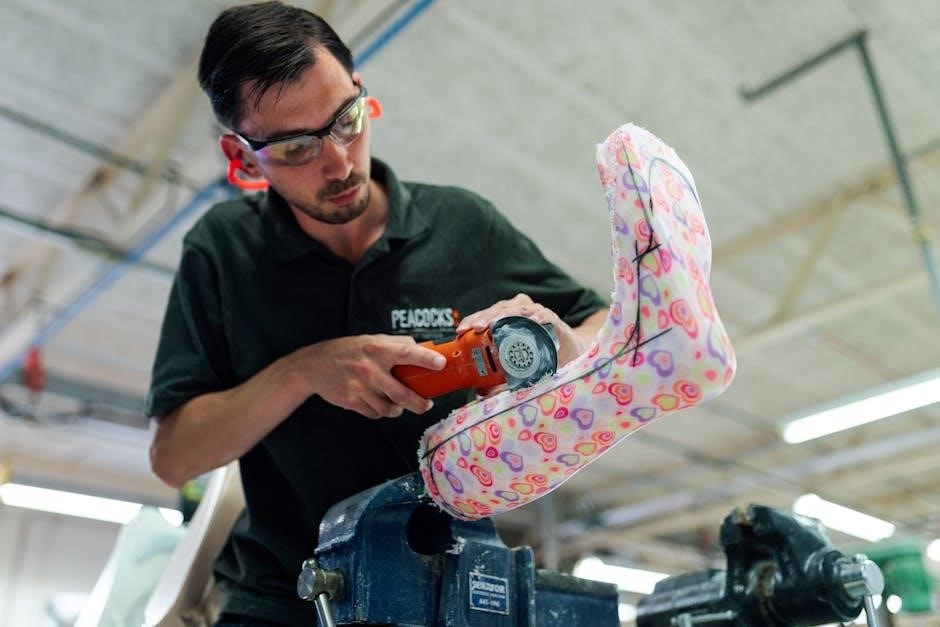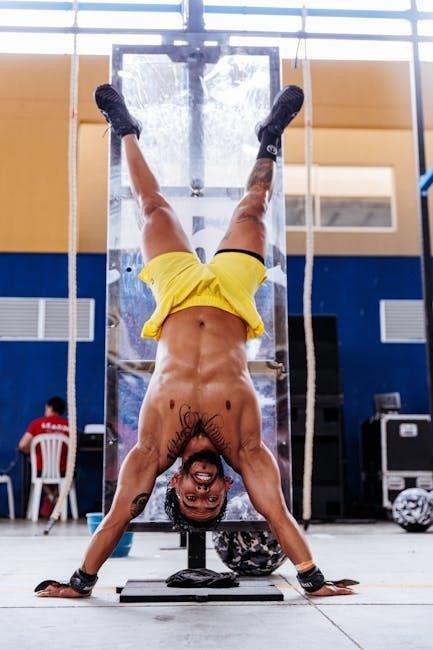Shin splints are a common issue for runners and athletes, causing lower leg pain. This article provides exercises and strategies to alleviate symptoms and promote recovery effectively.
What Are Shin Splints?
Shin splints, also known as medial tibial stress syndrome, refer to pain and tenderness along the inner edge of the tibia, the large bone in the lower leg. This condition often develops after repetitive or high-impact activities like running, dancing, or jumping. The pain can range from a dull ache to a sharp, stabbing sensation and may worsen during or after exercise. Shin splints are common among athletes and individuals who suddenly increase their physical activity or intensity. The discomfort is typically felt along the shin bone or just behind it and can be tender to the touch. If left unaddressed, shin splints can progress into a chronic issue, making it essential to address the problem early with appropriate treatment and exercises.
Common Causes of Shin Splints
Shin splints are primarily caused by repetitive stress and overuse of the lower leg muscles, tendons, and bone tissue. A sudden increase in mileage, intensity, or frequency of physical activity is a common trigger. Improper footwear, flat feet, or abnormal foot mechanics can also contribute, as they alter how forces are distributed during movement. Weakness in the calf or shin muscles can lead to poor running or walking mechanics, increasing the risk of shin splints. Additionally, running on hard surfaces or engaging in high-impact sports without proper conditioning can exacerbate the issue. Overtraining and inadequate recovery time further predispose individuals to this condition. Understanding these causes is essential for implementing effective prevention and treatment strategies.
Importance of Targeted Exercises
Targeted exercises play a crucial role in addressing shin splints by strengthening the muscles, improving flexibility, and enhancing recovery. These exercises help alleviate pain and reduce the risk of recurrence. Stretching routines, such as calf stretches and shin stretches, are essential for relieving tightness and improving circulation. Strengthening exercises, including toe raises and heel drops, build resilience in the lower leg muscles, while balance and reach exercises improve overall stability. By incorporating these exercises into a daily or weekly routine, individuals can address muscle imbalances and poor movement patterns that contribute to shin splints. Consistency in performing these exercises is key to promoting long-term recovery and preventing future injuries.

Understanding the Anatomy
The tibia and surrounding muscles are central to shin splints. The tibialis anterior muscle plays a key role in stabilizing the foot and ankle during movement. Weakness or overuse in these areas often leads to pain and discomfort, emphasizing the need for targeted exercises to strengthen and support the lower leg anatomy.
Muscles Involved in Shin Splints
The primary muscles involved in shin splints include the tibialis anterior, responsible for stabilizing the foot and ankle, and the peroneal muscles, which support lateral movement. Weakness or overuse of these muscles can lead to pain and inflammation along the shinbone. Additionally, the gastrocnemius and soleus muscles in the calf play a role, as tightness or imbalances can contribute to increased stress on the lower leg. Targeted exercises, such as resisted ankle inversion and toe raises, help strengthen these muscles, reducing the risk of shin splints. Proper stretching and strengthening routines are essential for maintaining muscle balance and preventing recurring issues.
The Role of the Tibialis Anterior Muscle
The tibialis anterior muscle plays a crucial role in stabilizing the foot and ankle during physical activity, such as running or jumping. It is the primary muscle responsible for dorsiflexion, helping to lift the foot upwards toward the shin. Overuse or weakness in this muscle can contribute to shin splints, as it increases stress on the lower leg. Strengthening exercises, such as resisted ankle inversion, can help improve its function and reduce the risk of injury. Proper activation and stretching of the tibialis anterior are essential for maintaining balance and preventing overcompensation by other muscles, which can exacerbate shin pain. Targeted exercises, as outlined in shin splint exercise PDFs, focus on enhancing the muscle’s endurance and flexibility to support overall lower leg health.
How Foot Posture Affects Shin Splints
Foot posture significantly influences the development of shin splints, as irregularities such as flat feet or high arches can alter lower leg mechanics. Flat feet, for instance, may cause overpronation, leading to increased strain on the tibialis anterior muscle and surrounding tissues. Conversely, high arches can result in underpronation, placing additional stress on the lower leg muscles. Improper footwear or lack of arch support can exacerbate these issues, contributing to shin pain. Addressing foot posture through orthotics or supportive shoes can help redistribute pressure and reduce the risk of shin splints. Strengthening exercises, such as toe raises and arch lifts, can also improve foot stability and alleviate discomfort. Proper alignment and support are essential for preventing and managing shin splint-related pain, especially for active individuals.

Stretching Exercises for Shin Splints
Effective stretching exercises, such as standing calf stretches, seated shin stretches, and toe raises, target the lower leg muscles to relieve shin splint discomfort and improve flexibility.
Standing Calf Stretch
The Standing Calf Stretch is a simple yet effective exercise for relieving shin splint discomfort. To perform this stretch, stand facing a wall with one hand on the wall for balance. Step one foot back about a foot, keeping the heel on the floor and the knee straight. Slowly bend the front knee, leaning forward until a gentle stretch is felt in the back of the lower leg. Hold the stretch for 15-30 seconds and repeat 2-3 times on each leg. This exercise targets the gastrocnemius and soleus muscles, which are often tight in individuals with shin splints. Regular practice can improve flexibility and reduce pain. It is important to keep the stretching leg’s heel on the ground and avoid bouncing. This stretch is widely recommended in shin splint exercises PDF guides for its effectiveness.
Seated Shin Stretch
The Seated Shin Stretch is a highly recommended exercise for addressing shin splints. To perform this stretch, sit on the floor with your legs extended straight in front of you. Loop a towel or resistance band around the ball of one foot and gently pull it toward your head. Focus on bending your foot upward, keeping your knee straight, until you feel a stretch in the front of your shin and lower leg. Hold this position for 15-30 seconds and repeat 2-3 times on each leg. This exercise effectively targets the tibialis anterior muscle, which is often strained in shin splints. Regular practice can improve flexibility and reduce discomfort. Many shin splint exercises PDF guides include this stretch as a key component of recovery routines due to its simplicity and effectiveness;
Toe Raises and Heel Drops
Toe Raises and Heel Drops are effective exercises for addressing shin splints by strengthening the muscles in the lower leg. To perform Toe Raises, stand on a flat surface and slowly lift your toes off the ground, holding for 5-10 seconds before lowering them back down. Repeat this motion 10-15 times. For Heel Drops, stand on the edge of a step or platform with your heels hanging off. Slowly lower your heels below the step, stretching the front of your shin, then raise them back to the starting position. This exercise targets the tibialis anterior muscle, which is often strained in shin splints. Many shin splint exercises PDF guides include these exercises as they are easy to perform and highly beneficial for recovery and prevention.
Anterior Compartment Stretch
The Anterior Compartment Stretch targets the muscles at the front of the lower leg, particularly the tibialis anterior, which is often affected by shin splints. To perform this stretch, sit on the floor with your legs extended straight in front of you. Loop a towel or resistance band around the ball of one foot and gently pull it toward your head, keeping your knee straight. You should feel a stretch along the front of your shin and calf. Hold the stretch for 15-30 seconds and repeat 2-3 times on each leg. This exercise helps improve flexibility and reduce tightness in the lower leg muscles, making it an essential part of shin splint recovery. Many shin splint exercises PDF guides recommend this stretch for its effectiveness in alleviating pain and preventing recurrence.

Strengthening Exercises
Strengthening exercises, such as resisted ankle inversion and Thera-Band exercises, target the muscles around the shin, improving resilience and reducing the risk of injury. Regular practice promotes recovery and prevents recurrence.
Resisted Ankle Inversion
Resisted ankle inversion is a highly effective exercise for strengthening the muscles around the shin and ankle. To perform this exercise, sit with your legs extended in front of you. Loop a resistance band around the inside of your foot or have a partner apply manual resistance. Slowly invert your ankle (turning it inward) against the resistance, holding for 2-3 seconds. Release slowly and repeat for 3 sets of 10-15 repetitions. This exercise targets the tibialis anterior muscle, improving strength and stability in the lower leg. Consistent practice helps reduce the risk of shin splints and enhances overall ankle mobility. It is essential to maintain controlled movements throughout the exercise to maximize its benefits.
Thera-Band Exercises
Thera-Band exercises are excellent for strengthening the lower leg muscles, particularly those affected by shin splints. To perform these exercises, loop the Thera-Band around a sturdy object or your foot. Sit or stand, depending on the exercise, and pull the band backward or upward to create resistance. Focus on dorsiflexion (lifting the toes toward the shin) and plantar flexion (pointing the foot downward). Hold each stretch for 5-10 seconds and repeat for 3 sets of 10-15 repetitions. You can also incorporate inversion (turning the foot inward) and eversion (turning the foot outward) movements. These exercises improve flexibility, reduce muscle tightness, and strengthen the tibialis anterior and peroneal muscles. Regular practice helps alleviate shin splint pain and prevents future occurrences. Use varying resistance levels to gradually increase muscle strength and endurance.
Step-Ups and Step-Downs
Step-Ups and Step-Downs are effective exercises for strengthening the lower leg muscles, particularly the tibialis anterior, which is often affected by shin splints. To perform Step-Ups, stand in front of a sturdy platform or step (6-8 inches high). Step up with one leg, bringing the other foot to meet it, then step back down slowly. Repeat on the other side. For Step-Downs, start by standing on the edge of the step with one leg, then slowly lower the other foot to the ground while keeping the heel of the working leg on the step. Both exercises improve balance, strength, and flexibility in the shin area. Perform 3 sets of 10-15 repetitions on each leg. These exercises can be modified by adjusting the step height or adding weights for increased resistance. Regular practice helps prevent future shin splint episodes by enhancing muscle endurance and stability.
Balance and Reach Exercises
Balance and Reach Exercises are excellent for improving stability and reducing shin splint discomfort. Stand on one leg, keeping the other foot lifted slightly off the ground. Extend your arms outward for balance and slowly reach in different directions, such as overhead or to the sides. Hold each position for 10-15 seconds before switching legs. For added challenge, perform this exercise on a BOSU ball or foam pad. This activity strengthens the muscles around the ankle and shin, enhancing proprioception and reducing the risk of overuse injuries. Aim for 3 sets of 10-12 repetitions on each leg. Regular practice improves overall lower leg stability, making these exercises a valuable addition to your shin splint recovery and prevention routine.

Prevention and Recovery
Preventing shin splints involves proper footwear, orthotics, and gradual intensity increases. Recovery includes rest, cross-training, and foam rolling to reduce inflammation and promote healing in the lower legs.
Proper Footwear and Orthotics
Wearing proper footwear and orthotics is crucial for preventing shin splints. Shoes with adequate arch support and cushioning can reduce stress on the lower leg muscles. Orthotic devices, such as shoe inserts, help correct foot posture issues like flat feet or overpronation, which are common causes of shin splints. When selecting footwear, ensure it fits well and is appropriate for your activity level. Replace worn-out shoes regularly, as they lose their supportive properties over time. Custom orthotics can also be beneficial for individuals with specific foot alignment needs. By addressing footwear and orthotic needs, individuals can significantly reduce the risk of developing shin splints and promote long-term recovery from existing conditions.
Gradual Increase in Exercise Intensity
A gradual increase in exercise intensity is essential for preventing shin splints. Sudden spikes in activity, such as running longer distances or increasing workout frequency too quickly, can overburden the lower leg muscles and bones. To avoid this, athletes and runners should slowly build up their training over weeks or months. For example, increasing weekly mileage by no more than 10% or adding strength exercises progressively can help the body adapt. Incorporating rest days and cross-training with low-impact activities, like swimming or cycling, allows muscles and bones to recover and strengthen. This approach reduces the risk of overuse injuries and promotes sustainable progress. By avoiding abrupt changes, individuals can maintain consistency in their training while minimizing the likelihood of shin splint discomfort.
Rest and Cross-Training
Rest is a critical component of managing shin splints, allowing the lower leg muscles and bones to heal. During periods of pain, reducing high-impact activities and incorporating rest days can prevent further aggravation. Cross-training with low-impact exercises, such as swimming or cycling, helps maintain fitness without straining the legs. These activities promote blood flow and strength without overloading the shin muscles. Alternating between rest and gentle exercises accelerates recovery and reduces the risk of recurrence. By prioritizing rest and diversifying workouts, individuals can address shin splints effectively while maintaining overall physical conditioning. This balanced approach ensures a smoother transition back to full activity levels.
Foam Rolling and Massage Techniques
Foam Rolling and Massage Techniques
Foam rolling and massage are effective tools for managing shin splints by reducing muscle tension and improving circulation. Use a foam roller to gently roll the calves, hamstrings, and quads, focusing on areas of tightness. Spend extra time on tender spots to release tension. Massage techniques, such as myofascial release or deep tissue massage, can target the tibialis anterior muscle and surrounding tissues. Regularly incorporating these practices helps alleviate pain, promotes recovery, and enhances flexibility. Consistency is key to preventing muscle imbalances that contribute to shin splints. Combine foam rolling with stretching exercises for optimal results and faster recovery.

PDF Resources for Shin Splint Exercises
Downloadable PDF guides provide detailed instructions and illustrations for shin splint exercises, including stretches, strengthening routines, and recovery techniques to alleviate pain and improve leg strength effectively.
Downloadable Guides and Illustrations
Downloadable PDF guides offer comprehensive resources for managing shin splints, featuring detailed illustrations and step-by-step instructions for effective exercises. These guides include stretches like the standing calf stretch, seated shin stretch, and toe raises, as well as strengthening routines such as Thera-Band exercises and resisted ankle inversion. Visual aids ensure proper form, maximizing the benefits of each exercise. Many guides also cover prevention strategies, such as proper footwear and gradual intensity increases. With clear instructions and visual demonstrations, these resources empower individuals to take control of their recovery and strengthen their lower leg muscles effectively. They are ideal for athletes, runners, and anyone seeking to alleviate shin splint pain and prevent future occurrences.
Detailed Instructional PDFs
Detailed instructional PDFs provide in-depth guidance for addressing shin splints through targeted exercises and recovery techniques. These resources often include step-by-step instructions, illustrations, and photos to ensure proper form and execution. Exercises such as standing calf stretches, seated shin stretches, and resisted ankle inversion are typically highlighted, along with Thera-Band routines for strengthening. The PDFs also emphasize the importance of rest, cross-training, and footwear selection to prevent recurrence. Many guides are designed for runners and athletes, offering tailored plans to improve lower leg strength and flexibility. With clear visuals and actionable advice, these PDFs serve as valuable tools for managing shin splint pain and enhancing overall leg health. They are ideal for individuals seeking a structured approach to recovery and prevention.
